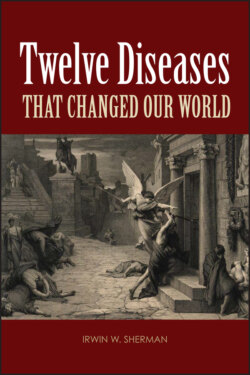Читать книгу Twelve Diseases that Changed Our World - Irwin W. Sherman - Страница 9
Hemophilia Blood will tell
ОглавлениеQueen Victoria (born in 1819), who reigned as Queen of the United Kingdom from 1837 to 1901, was in part responsible for bringing the Bolshevik Party into power, contributed to the demise of the House of Romanov, influenced the rise of Generalissimo Franco in Spain, and even arguably played an unwitting role in the ascendancy of the Third Reich in Germany. She did this not through her politics or her armies but through her genes, for she sowed the seeds of a debilitating and potentially fatal disease among the crowned heads of Europe by marrying off her daughters and granddaughters to them, with devastating effects on some of the royal houses concerned.
The disease that Queen Victoria passed on to her offspring was hemophilia or “bleeders' disease.” Hemophilia (literally “love of blood”) involves a failure of the blood to clot within a normal time. The defect is caused by a missing protein in the plasma, the liquid part of the blood, which is necessary for clot formation. Normal blood may take 5 to 15 min to clot, but in persons with hemophilia (hemophiliacs) the process may take hours or even days. The danger for a person with hemophilia is that even a small wound or bruise may lead to severe and uncontrolled internal bleeding and death.
Without clot formation, the blood flows freely from a wound until the circulatory system collapses—the afflicted person hemorrhages to death. Blood clotting is a complex affair involving a cascade of protein-protein interactions that converts a soluble protein of blood plasma, fibrinogen, into insoluble protein fibers of fibrin. The clotting cascade is like the Mother Goose rhyme “This is the house that Jack built”: This is the cat, that killed the rat, that ate the malt, that lay in the house that Jack built. In the clotting cascade: This is the break in the skin, so factor VIII can begin, converting prothrombin to thrombin; when thrombin converts fibrinogen to fibrin, the cross-linked result produces clottin'.
Eighty-five percent of all persons with hemophilia lack factor VIII, one of the clotting factors; the remainder lack factor V. In the absence of such factors, the individual may suffer internal hemorrhages after a minor bump or may die at an early age due to a bleeding crisis. It is possible to diagnose hemophilia as early as the eighth week of pregnancy by DNA hybridization techniques, but in the time of Queen Victoria no such test was available. In recent years, hemophiliacs could be treated with intravenous transfusions of a concentrated form of factor VIII that had been prepared from normal plasma. This form of treatment dramatically lengthened the life expectancy of hemophiliacs from about 20 years to more than 60. However, this therapy was unavailable before 1960, and even when it did become possible to correct hemophilia with transfusion of factor VIII, the dangers of the recipient becoming infected with human immunodeficiency virus and hepatitis virus from such preparations were great indeed. This complication of virus-contaminated preparations has been avoided since 1986, when the gene for factor VIII was cloned, making it possible to synthesize large quantities of “pure” factor VIII in virus-free tissue culture cells.
What is the cause of defective factor VIII? It can be the result of mutations (a change in a single nucleic acid base in the DNA) that produce a shortened version of factor VIII, leading to severe hemophilia, or there can be a complete absence of factor VIII, also leading to severe hemophilia. However, if the mutation results in the insertion of a “wrong” amino acid in factor VIII, the resulting hemophilia is mild.
